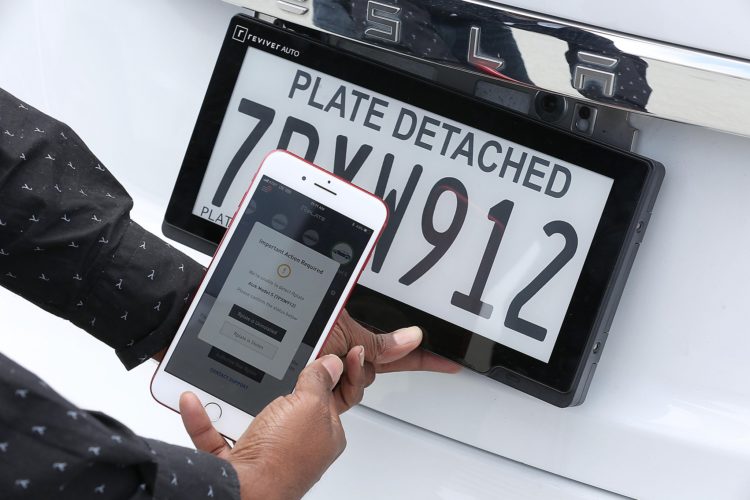The bumper sticker industry may be in for a scare. Digital License Plates have become a real thing for drivers in the state of California and this new technology allows the user to completely customize license plate design. While the amount of witty messaging and interesting digital plate designs could be endless, this tablet-like tech may also revolutionize convenience behind the wheel.
At the end of May, digital plates, or Rplates by manufacturer, Reviver Auto were approved for Californian roadways. For an up-front fee of $699.00 and another $7 monthly fare, the hunk of metal hanging above your vehicle’s bumper can be replaced with something that resembles a Kindle e-book reader.
Avoiding the chore of scraping off an old bumper sticker is nice, however the Rplates also automatically renew vehicle registration—eliminating the need for a sticker—help to track stolen vehicles, bring all vehicle data to one source, and will soon be able to pay highway tolls and parking fees.
This new type of license plate would effectively become a built-in radio frequency identification (RFID) tag. This capability would throw away need for a separate E-ZPass transponder on a vehicle’s windshield, and would link to the driver’s E-ZPass account. Furthermore, the digital license plate could completely change the nature of parking access. Currently, RFID readers and tags lift gates in lots and garages to streamline access. Additionally, license plate recognition (LPR) cameras take photos of vehicle plates to track car parking and guide drivers back to their vehicle’s resting spot. However, digitized vehicle plates could combine these processes and exponentially improve smart parking efforts. The new license plate tech will begin to interface with parking technology; opening lift gates and sharing information with LPR hardware.
These digital license plates would not only improve smart parking hardware, but could also advance software within this industry. Already, there are applications that allow users to pre-pay for parking and track peak parking hours, among other similar features. With license plates that can track driving trends, this influx of data will undoubtedly be used to make parking suggestions in an attempt to automate parking.
As the parking market leans toward single-device, connectivity—much like cellphones have—Reviver Auto’s CEO believes the digital plates’ affect could be very similar…
“Think about it like this: The difference between a flip phone and a smartphone is vast,” said Neville Boston. The executive who is looking to lead use of Rplates across the country sees a parallel between his product and the cell phone industry.
“I look at our product more like Apple, ours is building a compelling product that people want to buy and not selling or using people’s data,” he said. “I’m looking at an ecosystem play; it’s offering you value in a unique way. It’s [Apple’s] ecosystem that makes them so powerful because everything is connected. There’s value in the hardware. What’s really valuable long term and getting us connected is in our platform. It’s a unique value proposition.”
As these license plates are put to the test in other states like Texas, Arizona, and Florida, drivers will begin using them as bumper stickers, parking payment, RFID transponders, GPS locators, and general collectors of data. In the end, the capabilities of license plate technology are not far off from a smartphone or tablet. From here, consumer and industry need will dictate how this new technology will connect with the automotive industry as a whole.

